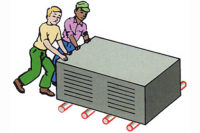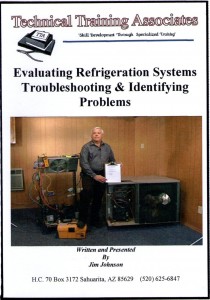Bob and Tim have had a big day at work — it’s 3:30 in the afternoon, and they are done for the day. They’re having coffee at a local restaurant, talking about their careers when Tim asked a question, “What is a ton of refrigeration, and why is it called a ton?”
Bob explained, “The earliest known cooling medium was ice. It goes way back and was used to preserve food over long periods of time. People then started using ice for cooling structures. Refrigeration for homes became popular in the late 1800s, and ice was used in insulated boxes for preserving food. There needed to be some way to establish a method of determining the capacity of these various refrigeration boxes. The first ice that was used was cut from lakes in the wintertime and stored in houses or buildings that were insulated with sawdust. The ice was covered with sawdust and would last all summer long if properly insulated and enough ice was available.”
Tim then asked, “How did they use ice to cool a building? Was this the first air conditioning”?
Bob said, “The term, ‘air conditioning,’ applies to the conditioning of air to cool, clean, humidify, or dehumidify. The southern part of the United States is hot and humid in the summer time. The first air conditioning systems actually stacked up blocks of ice, and fans forced air over the ice for the cooling and dehumidifying process. In order to know how many blocks of ice to order, or how many pounds of ice, some sort of measuring system had to be established. You learned in school that it takes 144 Btus to melt one pound of ice, at 32°F. The reason that you use ice in your beverage cooler instead of cold water is the cooling capacity of melting ice. If you put your beverages down in 32° water, it only takes one-half of a Btu to raise the temperature to 33°. With ice it takes 144 Btus to melt one pound of ice at 32°.”
Tim asked again, “How did we arrive at the system of using a ton?”
Bob said, “A ton of ice is 2,000 pounds. It takes 288,000 Btus to melt one ton of ice (144 Btus per pound x 2000 pounds = 288,000 Btus). If this is accomplished in a 24-hour period, that is a rate of one ton of ice per 24 hours, or a rate of 12,000 Btus per hour (288,000 Btus/24 hours per day = 12,000 Btus per hour). We call this one ton of refrigeration or air conditioning. In the old days, if they wanted to put enough ice in an airstream, they had to place a ton of ice in the airstream and melt it for every 12,000 Btus per hour that they wanted to remove from the air. When you pass air over 32° ice, it will remove moisture from the air because the ice is well below the dew point temperature of the air.”
Tim then asked, “When did they stop getting ice out of frozen lakes? How did they get the ice in the south?”
Bob said, “They used to cut the ice out of the northern lakes and ship it south by wagon or train. Warmer than normal winters and shipping costs, along with having to build insulated buildings in the south to store large amounts of ice, caused engineers to start thinking about ways to make ice closer to the place where it would be consumed. Thus, mechanical refrigeration was explored in detail in the late 1800s. An ice plant that could make a ton of ice in 24 hours was called a one-ton ice plant. Of course, much larger ice plants had to be developed in order to have enough ice. You used to go to the ice plant for your ice and get a block in 25-pound increments. They made the ice in cube shaped tubs, brought it out front, and chipped it to size or used cutters to make chipped ice in bags. Icemen used to deliver ice to homes for ice boxes before mechanical refrigeration. In apartment buildings, the iceman had to carry the ice to the upper floors. It was quite physical”
Tim said, “So, the term, ‘a ton of air conditioning or refrigeration,’ goes way back to the beginning. They established a way of rating the products way back then, and it still holds good today. When the products are rated like this, you can compare one product to another.”
Bob said, “Yes those early terms still work today — all rating systems are expressed in Btus per hour or tons of air conditioning or refrigeration. These terms were well thought out when they were developed, and no one has tried to change them through the years. It is also nice to know that it takes approximately a 1 horsepower (hp) compressor to generate a ton of air conditioning. This rule of thumb does not hold up in the refrigeration part of the business because it takes more than one horsepower for a ton of refrigeration at the lower temperatures. As you know, the design operating temperature for an air conditioning system is 40°. That is the temperature of the operating evaporator. When it comes to lower temperature refrigeration, the evaporator may operate down to -60°. It simply takes more horsepower per ton at these lower temperatures.”
Tim said, “When we talk to other technicians and engineers, we should thoroughly understand all of these terms. When we go to a store to look at an air conditioner generation device, we should understand these terms in order to compare one company’s equipment to another company’s.”
Bob said, “That is correct, particularly when we talk to engineers we need to know the technology. Engineers and technical people are sensitive to the way you say things and judge you on how you express yourself and what kinds of terms you use. They know that you know what you’re talking about when you express yourself in the correct terms.”
Publication date: 12/19/2016
Want more HVAC industry news and information? Join The NEWS on Facebook, Twitter, and LinkedIn today!











